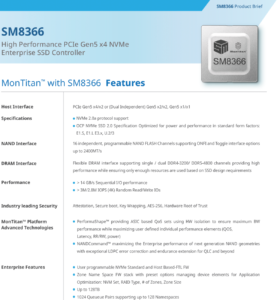©2021 Reporters Post24. All Rights Reserved.
Silicon Motion has today introduced its first SSD platform featuring a PCIe Gen5 interface. SMI’s MonTitan SM8366 controller offers an unbeatable sequential performance of over 14GB/s. It also provides support for existing, specialty, and next-generation 3D NAND memory types, including 3D QLC NAND and even higher density flash. The platform is aimed at enterprise-grade applications though some of its innovations may become a part of SMI’s consumer-oriented SSD controllers.
Silicon Motion’s MonTitan SM8366 is an NVMe 2.0a-compliant controller based on Arm core complexes. It features 16 NAND flash channels with a 2400 MT/s ONFI/Toggle interface to connect up to 128TB of 3D TLC, 3D QLC or XL-Flash memory. The controller supports DDR4-3200 and DDR5-4800 DRAM buffers with a dual-channel interface as well as a PCIe 5.0 x4 interface or dual independent x2/x2 or x1/x1 interfaces. SMI’s MonTitan family also includes its SM8308 controller that has eight NAND channels, but the same feature set as its higher-end counterpart.
SMI says that SSDs based on the MonTitan SM8366 will be able to offer sustained sequential read performance of over 14 GB/s as well as sustained random read/write performance of 3 million/2.8 million 4K IOPS. To put the numbers into context, performance of the SM8366-powered drives promises to be higher than that of Samsung’s PM1743 drive featuring a PCIe 5.0 x4 interface.
But performance is only a part of the equation when it comes to enterprise-grade SSDs. The MonTitan SM8366 is a sophisticated platform with a plethora of features that support datacenter and enterprise use cases. In particular, SSDs based on the SM8366 will support OCP Datacenter NVMe SSD requirements as well as the Zoned Namespaces (ZNS) specifications to handle up to 1024 queuing pairs, supporting up to 128 namespaces. In addition, the chip supports AES 256-bit encryption, attestation, hardware root of trust, Secure Boot, and TCG Opal.
Among the key features of Silicon Motion’s new datacenter SSD platform are its proprietary PerformaShape and NANDCommand capabilities. SMI’s PerformaShape is a Quality-of-Service capability that isolates certain SSD operations to maximize both bandwidth as well as user defined individual performance elements (QoS, latency, RR/RW, power). The NANDCommand feature seems to be even more interesting as it enhances LDPC algorithms with error correction and endurance extension for next-generation NAND devices with more layers as well as more than four bits per cell. We are unsure whether penta level cell (PLC) 3D NAND will be viable anytime soon in the enterprise, but at least SMI’s SM8366 platform is said to be ready for it.

The new enterprise-grade SM8366 controller from Silicon Motion supports a variety of memory types thanks to the company’s 5th Generation LDPC algorithms and extensions enabled by NANDCommand. Right now, SMI says that its platform can, among other types, work with Kioxia’s 3D BiCS NAND and XL-Flash memory, the latest 176-layer 3D QLC NAND memory from Micron, and various types of 3D NAND chips from YMTC.
Silicon Motion’s SM8366 controller is made using a 12nm-class fabrication process and comes in a 21mm x 21mm FCBGA package with a built-in aluminum heat spreader. The chip will enable fabrication of SSDs in E1.S, E1.L, and E3.S modern form-factors as well as U.2/U.3 legacy form-factors.
SMI’s MonTitan SSD platform featuring the SM8366 controller will be available to early engagement platforms in Q4 2022 as reference hardware design kits with licensable turnkey and layered firmware stacks to enable development of customer differentiated solutions.

